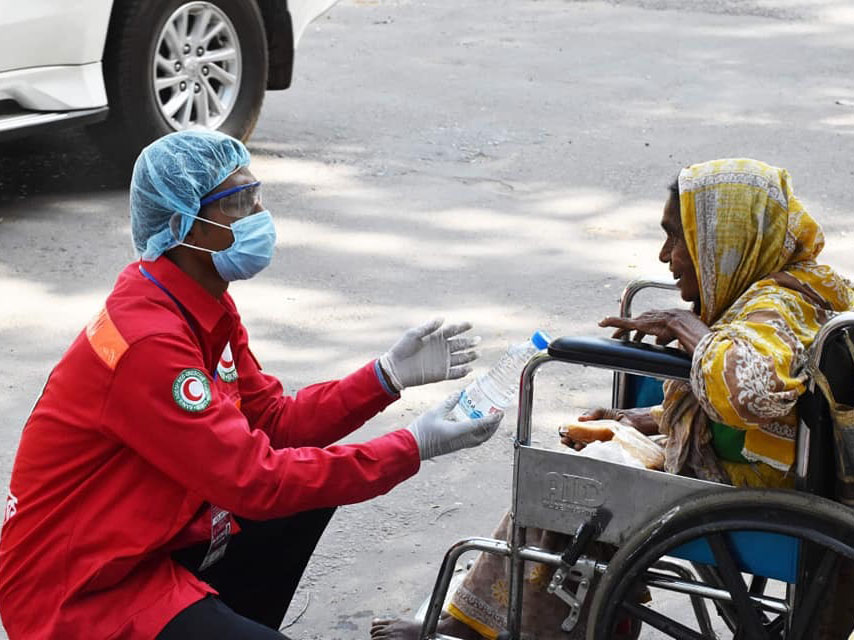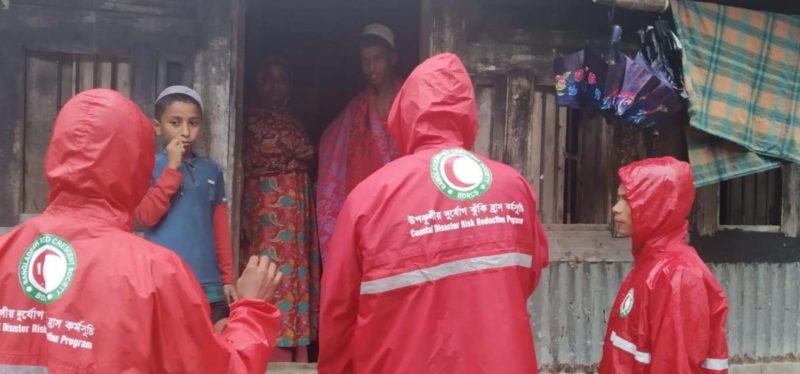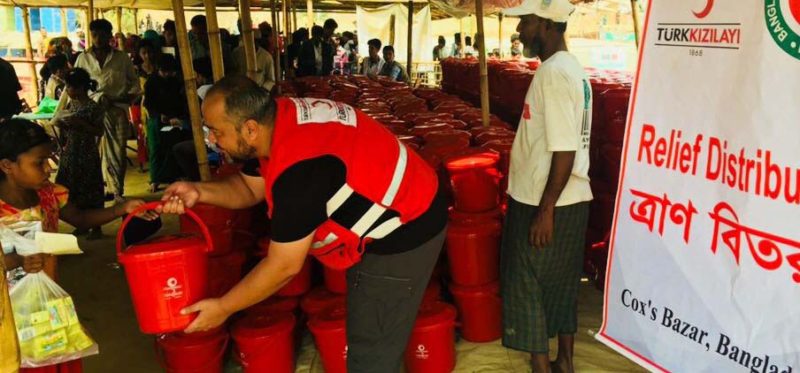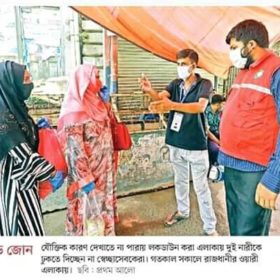Community Engagement & Accountability (CEA)
Community engagement and accountability (CEA) is an approach to Red Cross and Red Crescent programming and operations. It is supported by a set of activities that help put communities at the center of what we do, by integrating communication and participation throughout the programme cycle or operation.
CEA is the process of and commitment to providing timely, relevant and actionable life-saving and life-enhancing information to communities. It is about using the most appropriate communication approaches to listen to communities’ needs, feedback and complaints, ensuring they can actively participate and guide Red Cross Red Crescent actions. CEA supports those involved in programmes and operations to adopt innovative approaches to better understand and engage with people and communities and help them address unhealthy and unsafe practices. It maximizes the Red Cross Red Crescent’s unique relationship with the community to help them speak out about the issues that affect them and influence decision and policy-makers to implement positive changes.
While CEA is not a new or stand-alone programme, adopting a more systematic approach to CEA contributes to improved accountability to communities, which builds acceptance and trust and supports more sustainable programme outcomes. Ultimately, this helps communities take an active role in building long-term resilience by enabling them to become more knowledgeable, skilled, connected and to bring about the behavior and social changes needed to address risks and underlying vulnerabilities.
Pillars of Community engagement and accountability (CEA)
- Community participation and feedback: CEA supports those involved in our programmes and operations to share honest, timely and accessible information with communities about who we are and what we are doing, find ways to engage them in guiding programme design and delivery, and to set up systems for responding and acting on feedback, questions and complaints.
- Providing information as aid In the midst of a disaster or conflict, people need information as much as water, food, medicine or shelter. CEA supports those involved in our programmes and operations to share timely, actionable and potentially life-saving information with communities quickly, efficiently and at large-scale, using systems such as SMS, social media or radio broadcasts.
- Behaviour and social change communication CEA helps behavior and social change programmes to gain an insight into the perceptions and behaviours of different groups, and to develop engaging and targeted messages. It also provides innovative and participatory communication approaches that support communities to adopt safer and healthier practices.
- Evidence-based advocacy Community members are experts on the challenges that affect them and their solutions, but they can find it difficult to make their voices heard by the relevant authorities or organizations. CEA helps create spaces for communities to speak out about the issues that affect them and make their voices heard to influence decision-makers to take action.
Why community engagement and accountability is important
- 1. Leads to better, more effective programming
Asking and listening to people’s needs and opinions, and involving them in designing and delivering programmes, helps us to properly understand the situation and people’s priorities, which leads to more responsive, relevant and sustainable programmes.
- Improves acceptance and trust Open and honest communication about who we are and what we are doing is a mark of respect and builds trust. It can help address rumours and prevent potential reputational and security risks, all of which enhances acceptance by communities.
- Feedback and complaints are good Feedback and complaints provide us with valuable information we can use to improve our programmes and operations. These act as an early-warning system for implementation problems and cases of sexual exploitation, abuse and corruption, allowing us to address these quickly before they escalate. Feedback is also critical to shaping appropriate behaviour and social change communication initiatives.
- Helps to save lives Information – such as how to reconnect with your family, which hospitals are functioning or how to make safe drinking water – can save lives, livelihoods and resources.
- Empowers people and builds community resilience People affected by crisis are not helpless victims. With the right information, people can make informed decisions, find answers to their problems and connect with others to organize their own response – all of which builds long-term community resilience.
- Supports positive behaviour and social change Simply providing information about an issue is rarely enough to change entrenched behaviours. CEA provides innovative approaches to enable us to better understand and engage with communities, and help them adopt safer and healthier practices.
- Recognizes the community as experts and partners Local people are the most knowledgeable about their situation and have a right to be active partners in the development, relief and recovery of their communities. Drawing on that knowledge and expertise through participation and feedback can build community resilience and improve the assistance and protection we provide.
- Supports National Societies to fulfil their auxiliary role As an auxiliary to public authorities in the humanitarian field, National Societies play an important role, both to facilitate community participation in decision-making processes and to act as a bridge between communities and authorities at national and local levels. Therefore, National Societies must earn the trust and respect of both communities and public authorities.
- Contributes to ‘do no harm’ programming There is always a risk that our presence and activities can have negative unintended consequences on a community. Good community engagement helps us achieve a solid understanding of the local environment and the role we play, both actual and perceived, whether we operate in a context with high levels of social instability, violence and conflict, or within more stable and predictable settings.
- Helps to manage communities’ expectations Dialogue with communities is essential in order to anticipate their needs, understand their circumstances and priorities and manage their expectations in relation to what they can expect from the National Society and who is eligible for support.
CEA programme cycle:
- Assessment
- Design and Planning
- Implementation and Monitoring
- Evaluation and Learning
CEA is a cross-cutting issue of BDRCS and widely implemented at BDRCS all programs and Population Movement Operation (PMO) at Cox’s Bazar. BDRCS organized two days long basic CEA training at Dhaka level program staff on 3-4 April,2019 and PMO level program staff on 16-17 January,2019. Besides that, BDRCS has a Hotline number (01811-458524) where people can make a phone call for program related information and other purpose. Total 1963 calls received from hotline. Major phone call received about Rana Plaza collapse, Nimtoli and Chalk Bazar fire destruction, Tunisia boat accident, landslides and flood related information.
CEA aims to save and improve lives through the provision of timely, relevant and accurate information and support an environment of transparency and accountability through the creation of feedback mechanisms.
BDRCS, in collaboration with IFRC, took initiative of introducing CEA through conducting the Baseline Assessment in 2013 to institutionalize. CEA is to support an overall environment of accountability and transparency for Program/Project/Operation communities/beneficiaries. Complaint and Response Mechanism (CRM) is the important tools of CEA. Feedback & Response mechanism is implemented at different project & programs of BDRCS. Presently CRM is implementing at Coastal Disaster Risk Reduction Program mostly known as Coastal DRR program at Kolapara (Patuakhali),ShoronKhola(Bagerhat) and PMO at Cox’s Bazar. 11 CRM orientation is conducted at Coastal DRR and Integrated Flood Recovery Project (IFRP). BDRCS has a plan to continue the Feedback and Response Mechanism issues at all the intervention in near future. In this process community can know the proper channel to make any complaints/feedback if they have any dissatisfaction about our service, our strategy and our behaviours.
Very recently three CEA personnel from BDRCS participated Asia Pacific Regional CEA training at Myanmar that assist to accelerate CEA and CRM issues at other project/programs of BDRCS.
- Sayma Ferdowsy
Director, Planning & Development and Communication, BDRCS NHQ, Dhaka
Email: sayma.ferdowsy@bdrcs.org, Mobile: +880 1811458516
Md. Amirul Islam
Manager, CEA, BDRCS NHQ
Email: amirul[email protected], Mobile: +8801916068991 +8801712200390
Raqibul Alam
Senior Manager, Programme Support, IFRC
Email: [email protected], Mobile: +8801714069707











































